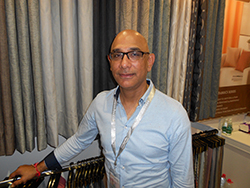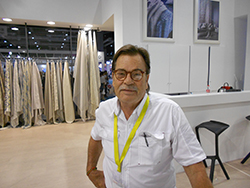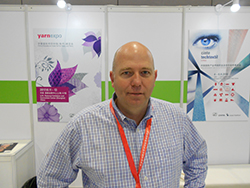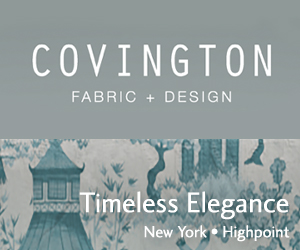The Use of New Fibers and Yarns Enable the Chinese to Offer Middle to High-End Ranges of Decorative Fabrics
November 17, 2017
SHANGHAI — China is no longer a cheap source of decorative fabrics and prices are increasing regularly, according to attendees at this year’s Shanghai Intertextile Fair here.
The use of new fibers and yarns has enabled Chinese suppliers to move to a higher end range of fabrics and buyers are not complaining about price increases either.
“After 20 years of doing business with China, I have seen incredible changes in the past three years in terms of quickly addressing environmental issues that are changing blue skies to hazy brown skies”, says Carlo Boselli, CEO, ST & I, Milano Italy, an importer of polyester and linen fabrics.
 Carlo Boselli, CEO, ST & I, Milano Italy
“The government has rightly forecasted the future problems. It has taken action to curb pollution seriously. I cannot imagine a country that closes its 255 industrial facilities, including an oil refinery to shut for 14 days within a 300 km radius from Hangzhou to make the sky look blue again ahead of the G20 summit”, Boselli says. “Brands like Adidas, Nokia, Apple and others seek social audit. Now, the Chinese are increasingly inclined to comply with buyer requirements. Indeed, the prices are going up due to these new social and labor costs but this is not a deterrent to increase our purchases as quality has also improved substantially”, he adds. “Yes indeed prices are increasing but doing business with China is now different,” says Glen Whitchurch, Managing Director, Trabeth Textiles, Melbourne, Australia, “When we started import and distribution of Chinese furnishing fabrics in 2012 we had to order a minimum of 1000 meters per color/design but now we order 300 as well as cut lengths”‘, Whitchurch says. “Apart, a wider selection in terms of design and quality range meets our market tastes,” he adds. “Earlier some Chinese companies were unable to accept orders due to difficulty in obtaining an export license but now it is liberalized, making import from more suppliers easier and our business is expanding,” says. Vincent Kwon, General Manager of Hangzhou Galaxy Limited, China. He has 15 years of in-depth experience of sourcing Chinese fabrics. He also markets imported lines of furnishings into China. “The current happenings are not all rosy for Chinese manufacturers who are sailing seriously in troubled waters. Excluding large well established mills, the smaller companies are facing closures due to strict implementation of pollution control measures taken by the concerned authorities”, says Kwon. Also many companies have closed their mill if it has failed emission parameters and stocks are running low. “Those who can invest again in expensive pollution control equipment and re-locate as instructed by the authorities will only leave a few efficient companies to operate,” Kwon observes. Short term pains exist but long term benefits come from the fact that China is environmentally conscious. This will be to its advantage also, Kwon notes. In China buying an artwork to translate to creative weaves is still not popular as a shorter option is achieved by clicking pictures which is a big time saver except for the few select companies who create their own designs, Kwon observes.
Carlo Boselli, CEO, ST & I, Milano Italy
“The government has rightly forecasted the future problems. It has taken action to curb pollution seriously. I cannot imagine a country that closes its 255 industrial facilities, including an oil refinery to shut for 14 days within a 300 km radius from Hangzhou to make the sky look blue again ahead of the G20 summit”, Boselli says. “Brands like Adidas, Nokia, Apple and others seek social audit. Now, the Chinese are increasingly inclined to comply with buyer requirements. Indeed, the prices are going up due to these new social and labor costs but this is not a deterrent to increase our purchases as quality has also improved substantially”, he adds. “Yes indeed prices are increasing but doing business with China is now different,” says Glen Whitchurch, Managing Director, Trabeth Textiles, Melbourne, Australia, “When we started import and distribution of Chinese furnishing fabrics in 2012 we had to order a minimum of 1000 meters per color/design but now we order 300 as well as cut lengths”‘, Whitchurch says. “Apart, a wider selection in terms of design and quality range meets our market tastes,” he adds. “Earlier some Chinese companies were unable to accept orders due to difficulty in obtaining an export license but now it is liberalized, making import from more suppliers easier and our business is expanding,” says. Vincent Kwon, General Manager of Hangzhou Galaxy Limited, China. He has 15 years of in-depth experience of sourcing Chinese fabrics. He also markets imported lines of furnishings into China. “The current happenings are not all rosy for Chinese manufacturers who are sailing seriously in troubled waters. Excluding large well established mills, the smaller companies are facing closures due to strict implementation of pollution control measures taken by the concerned authorities”, says Kwon. Also many companies have closed their mill if it has failed emission parameters and stocks are running low. “Those who can invest again in expensive pollution control equipment and re-locate as instructed by the authorities will only leave a few efficient companies to operate,” Kwon observes. Short term pains exist but long term benefits come from the fact that China is environmentally conscious. This will be to its advantage also, Kwon notes. In China buying an artwork to translate to creative weaves is still not popular as a shorter option is achieved by clicking pictures which is a big time saver except for the few select companies who create their own designs, Kwon observes.
 Kirpal Mahtani (Michale), Marketing Director, P . N. Raj Departmental Stores Singapore
Kirpal Mahtani (Michale) started importing blackouts and dim-outs from China three years ago. Initially the company hesitated about Chinese goods but began buying in spite of higher prices. “I visited a few mills but cleanliness from loom stage to warehousing was an issue and it was difficult to convince them the importance of keeping cleanliness as they did not speak English,” recalls Michale, Marketing Director, PN. Raj Departmental Stores Singapore. ‘Now in my recent visit, I saw a sea change in their attitude and a few are able to speak English who are willing to listen and gladly offer solutions, he noted. ‘Now I am at ease in doing business with Chinese suppliers and prices are more competitive,” adds Michale. “Since 2002, China is a very important source for upholstery and drapery fabrics and we import large quantities but over the last three years we are very satisfied with improving quality especially in terms of new varieties and finishes,”’ says Paval Krivenko, Import Manager, Textile Data, Moscow, Russia a decorative fabric distributor. The biggest change is that batch quantities have been reduced and the variety of textures now offered meets Russian consumer tastes, he notes. “To sum up, we had three suppliers earlier, seven now and our imports have multiplied though prices are increasing regularly”, Krisvenko states.
China’s communist government has created a flourishing and thriving capitalistic environment for its entrepreneurs over the last decade, observes Johnny Keeton, sales agent, Dallas, Texas, USA.
Kirpal Mahtani (Michale), Marketing Director, P . N. Raj Departmental Stores Singapore
Kirpal Mahtani (Michale) started importing blackouts and dim-outs from China three years ago. Initially the company hesitated about Chinese goods but began buying in spite of higher prices. “I visited a few mills but cleanliness from loom stage to warehousing was an issue and it was difficult to convince them the importance of keeping cleanliness as they did not speak English,” recalls Michale, Marketing Director, PN. Raj Departmental Stores Singapore. ‘Now in my recent visit, I saw a sea change in their attitude and a few are able to speak English who are willing to listen and gladly offer solutions, he noted. ‘Now I am at ease in doing business with Chinese suppliers and prices are more competitive,” adds Michale. “Since 2002, China is a very important source for upholstery and drapery fabrics and we import large quantities but over the last three years we are very satisfied with improving quality especially in terms of new varieties and finishes,”’ says Paval Krivenko, Import Manager, Textile Data, Moscow, Russia a decorative fabric distributor. The biggest change is that batch quantities have been reduced and the variety of textures now offered meets Russian consumer tastes, he notes. “To sum up, we had three suppliers earlier, seven now and our imports have multiplied though prices are increasing regularly”, Krisvenko states.
China’s communist government has created a flourishing and thriving capitalistic environment for its entrepreneurs over the last decade, observes Johnny Keeton, sales agent, Dallas, Texas, USA.
 Johnny Keeton, Sales Agent, Texas, USA
“Overall quality is up for the Chinese manufacturers and they produce the cheapest to the most expensive range of decorative fabrics and the recent change in the use of new yarns has given the manufacturers a special edge leaving other suppliers behind moving in to the high-end fabrics range”, Keeton adds.
“It will not be long before the Chinese will establish factories in America, which will create more employment in the USA, which is welcome,” he explains. “Of course the hardening of prices is understandable since the Chinese are moving towards up-market range”, says Keeton. “All was well for 17 years and we only did business in low value curtain fabrics buying between $2-2.50 a meter: Recently, the Chinese have directly entered the markets selling lower than our imported price”, begins Rasheed Patel, Owner Papini Trading, wholesalers of wall coverings, curtaining and accessories, Pietermaritzzhurg, South Africa. The company quickly vacated the cheaper segment and moved to middle and high-end collections that cost between $ 5-10. “Now the change is we don’t import big quantities but 100 meters per color instead of 1000 meters earlier. “We have independent collections and run a book program but we still import from China and the going is good” concluded Patel.
Johnny Keeton, Sales Agent, Texas, USA
“Overall quality is up for the Chinese manufacturers and they produce the cheapest to the most expensive range of decorative fabrics and the recent change in the use of new yarns has given the manufacturers a special edge leaving other suppliers behind moving in to the high-end fabrics range”, Keeton adds.
“It will not be long before the Chinese will establish factories in America, which will create more employment in the USA, which is welcome,” he explains. “Of course the hardening of prices is understandable since the Chinese are moving towards up-market range”, says Keeton. “All was well for 17 years and we only did business in low value curtain fabrics buying between $2-2.50 a meter: Recently, the Chinese have directly entered the markets selling lower than our imported price”, begins Rasheed Patel, Owner Papini Trading, wholesalers of wall coverings, curtaining and accessories, Pietermaritzzhurg, South Africa. The company quickly vacated the cheaper segment and moved to middle and high-end collections that cost between $ 5-10. “Now the change is we don’t import big quantities but 100 meters per color instead of 1000 meters earlier. “We have independent collections and run a book program but we still import from China and the going is good” concluded Patel.
 Glen Whitchurch, Managing Director, Trabeth Textiles, Melbourne, Australia
by Vishwanath.S
Glen Whitchurch, Managing Director, Trabeth Textiles, Melbourne, Australia
by Vishwanath.S
 Carlo Boselli, CEO, ST & I, Milano Italy
Carlo Boselli, CEO, ST & I, Milano Italy Kirpal Mahtani (Michale), Marketing Director, P . N. Raj Departmental Stores Singapore
Kirpal Mahtani (Michale), Marketing Director, P . N. Raj Departmental Stores Singapore Johnny Keeton, Sales Agent, Texas, USA
Johnny Keeton, Sales Agent, Texas, USA Glen Whitchurch, Managing Director, Trabeth Textiles, Melbourne, Australia
Glen Whitchurch, Managing Director, Trabeth Textiles, Melbourne, Australia















